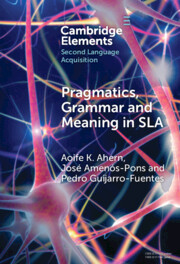Element contents
Pragmatics, Grammar and Meaning in SLA
Published online by Cambridge University Press: 29 March 2024
Summary
- Type
- Element
- Information
- Online ISBN: 9781009026888Publisher: Cambridge University PressPrint publication: 18 April 2024
References
- 3
- Cited by

